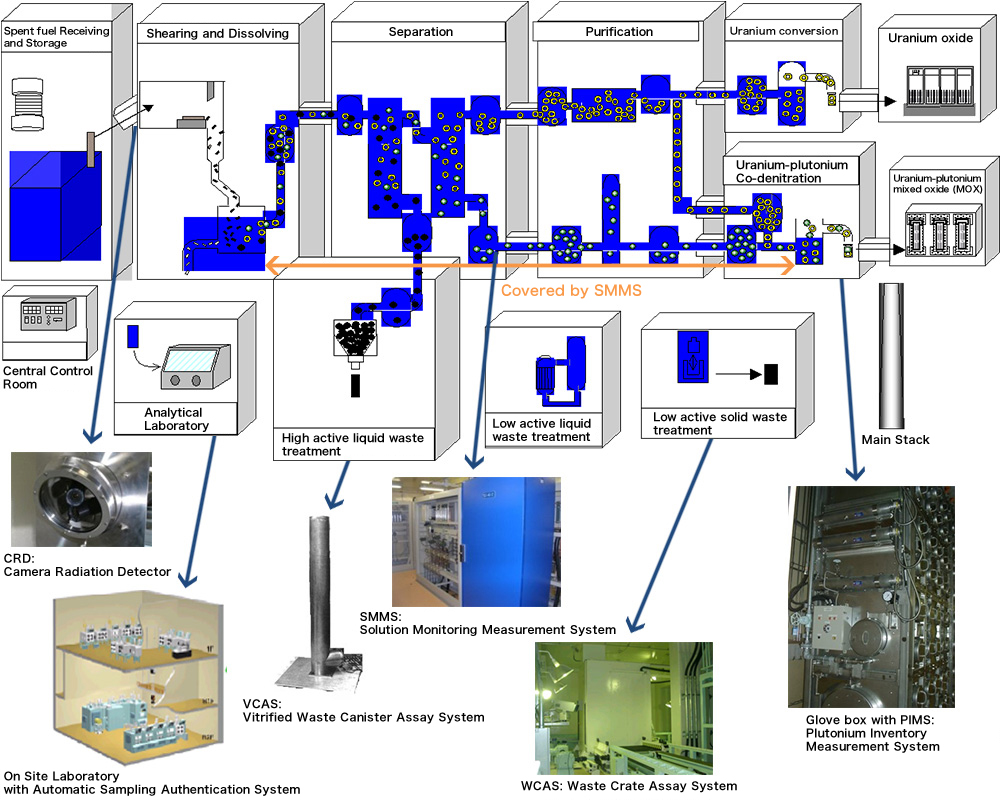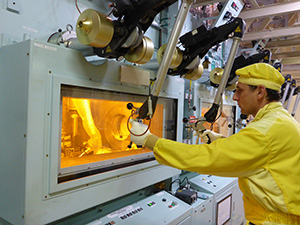Safeguards for assuring peaceful use of nuclear energy
Peaceful use of nuclear energy
Japan, which is the only NPT non-nuclear weapon state that possesses the nuclear fuel cycle program under the "Atomic Energy Basic Law" that allows only peaceful nuclear activities, and its "Three Non-Nuclear Principles" of not possessing, producing, or permitting the introduction of nuclear weapons into the country, in line with Japan’s Peace Constitution.
Japan embraced the NPT as a public commitment to use nuclear materials and technology only for peaceful purposes, and all the nuclear facilities are under the IAEA Safeguards based on the NPT.
IAEA Safeguards
Many non-nuclear-weapon state parties to the NPT have concluded the agreements called "Comprehensive Safeguards Agreements" ("INFCIRC/153 type Safeguards Agreements" or "Full-scope Safeguards Agreements") with the International Atomic Agency (IAEA). As for Japan, the Agreement entered into force on December 2, 1977.
The objective of safeguards measures under Comprehensive Safeguards Agreements is the timely detection of diversion of significant quantity of nuclear materials from peaceful nuclear activities to the manufacture of nuclear weapons or of other nuclear explosive devices or for unknown purposes, and the deterrence of such diversion by the risk of early detection.
"Significant quantity" is defined in the IAEA Safeguards Glossary (2001 Ed.) as the approximate amount of nuclear material for which the possibility of manufacturing a nuclear explosive device cannot be excluded: for example, 8 kg of plutonium or U-233, or 25kg of enriched uranium containing over 20% or more of U-235.
For Japan, the broader conclusion(note) was drawn at the meeting of the IAEA Board of Governors in June 2004. The application of Integrated Safeguards began on September 15, 2004.
Japan was the first country conducting large-scale nuclear activities to which the Integrated Safeguards were applied.
The application of Integrated Safeguards warrants the high transparency of Japan’s nuclear activities, but is also expected to reduce the burden on its safeguards implementation. In addition, the IAEA is reviewing the development.
Note: Broader conclusion is an IAEA safeguards conclusion that there is no indication of diversion of declared nuclear material from peaceful nuclear activities and no indication of undeclared nuclear material and nuclear activities in the state.
Source: Disarmament and Non-Proliferation Policy of Japan, March 2011, Ministry of Foreign Affairs of Japan
Reference
Statement by the Press Secretary/Director-General for Press and Public Relations, Ministry of Foreign Affairs, on the Implementation of Integrated Safeguards by IAEA to Japan's Nuclear Activities, September 14, 2004
- Japan welcomes the notification from the International Atomic Energy Agency (IAEA) that from September 15 it will implement integrated safeguards to Japan's nuclear activities.
- The IAEA's decision is based on the broader safeguards conclusion reached at the IAEA Board of Governors meeting in June this year that, as a result of verification activities based on its comprehensive safeguards agreement and additional protocol, there was neither indication of the diversion of nuclear material placed under safeguards nor indication of undeclared nuclear material or activities in Japan. Japan is the first case in which integrated safeguards are implemented to a state with large-scale nuclear activities, and it is extremely significant in that regard.
- Under the current international situation, where the demand for the IAEA safeguards is on the increase, it is becoming increasingly important for the IAEA to improve the efficiency of its safeguards activities through the effective use of its limited safeguards resources. The implementation of integrated safeguards is also beneficial from such a viewpoint.
- Japan intends to cooperate proactively with the IAEA safeguards activities and continue its cooperation with the IAEA to further strengthen and improve the efficiency of the IAEA's safeguards activities, with a view to securing maximum transparency of its nuclear activities.
Credible Safeguards at Rokkasho Reprocessing Plant
Strict safeguards have been applied to the Rokkasho Reprocessing Plant.
The advanced safeguards systems for the Rokkasho Reprocessing Plant, of which no other examples exist in the world, have been highly regarded by safeguards experts.
It is verified by IAEA and Nuclear Regulatory Authority’s Japan Safeguards Office (JSGO) that all nuclear materials remains in declared activities at the Rokkasho Reprocessing Plant according to the Safeguards Agreement.
In addition, inspectors are stationed in shifts at the Rokkasho Reprocessing Plant for 24 hours while the plant is in operation.
LASCAR (Large Scale Reprocessing Plant Safeguards)
In order to establish the effective and efficient safeguards at RRP, the safeguards discussions with the IAEA was initiated in 1988, but at that time no available model or guideline that could be used as a reference. Therefore, during the period of 1988 through 1992, a multinational forum, referred to as “LASCAR” (Large Scale Reprocessing Plant Safeguards) participated by US, UK, Japan, French, Germany, IAEA and EURATOM), provided the recommendations how effective safeguards approach could be implemented to a large scale reprocessing plant with maintaining efficient uses of resources.
Examples of Safeguards at Rokkasho Reprocessing Plant
1. Automatic Verification Systems and Process Monitoring Systems
Automatic Verification Systems such as VCAS, WCAS and PIMS and Process Monitoring Systems such as CRD and SMMS realized a continuous inspection regime that was required as the safeguards approach to the Rokkasho Reprocessing Plant. (See Figure 1)
These advanced safeguards technologies are introduced along the flow path of the nuclear materials in the whole process, including the nuclear waste treatment process and product storage.
A combination of above systems ensures credible safeguards activities at the Rokkasho Reprocessing Plant.

Figure 1: Automatic Verification Systems and Process Monitoring Systems at Rokkasho Reprocessing Plant
2. Integrated Inspection Information System
IAEA and JSGO have developed and introduced the Integrated Inspection Information System (I3S). The I3S collects inspection data from all the safeguards systems automatically to support evaluation of inspections and diagnosis of safeguards equipment.
3. Near-Real Time Material Accountancy
Near-Real Time Material Accountancy (NRTA) is implemented for timely detection as an advanced nuclear material accountancy technique. The application of NRTA for short-period sequence analysis provides for early indication of the diversion.
4. On-Site Laboratory

Analysis operation by IAEA at OSL
IAEA and JSGO are jointly setting up their own on-site laboratory (OSL) in the Rokkasho Reprocessing Plant. OSL provides timely analytical results incorporated with the Automatic Sampling Authentication System.
It also allows IAEA and JSGO to identify questionable results.
International Cooperation
The Rokkasho Reprocessing Plant has historically been engaged in improving safeguards accuracy through its activities. Accumulated data which are obtained from the Rokkasho Reprocessing Plant has been helped to developed safeguards technologies to detect undeclared nuclear activities.